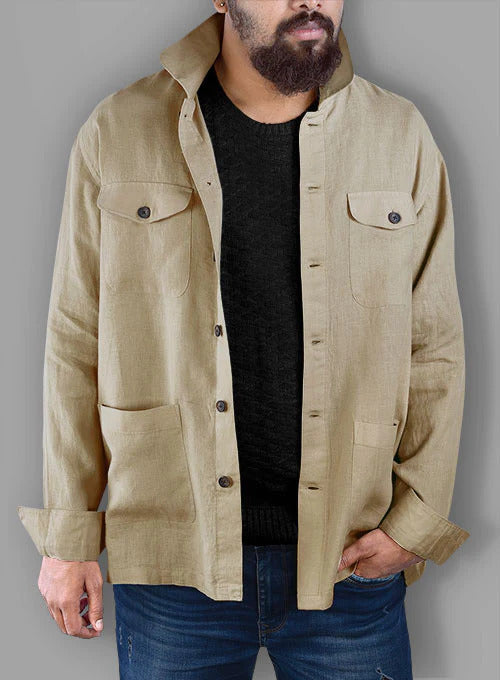If you enjoy wearing layered outfits, you may want to invest in an overshirt. Overshirts are designed specifically for use in layered outfits. Some of them have short sleeves, whereas others have long sleeves. Regardless, you can wear an overshirt over another shirt, thereby creating a layered outfit. Here are 10 important things you need to know about overshirts.
#1) Available in Linen
While you can find them in different materials, linen is a popular choice of material for overshirts. Linen is strong, lightweight, and it dries faster than cotton. With these properties, you can easily wear a linen overshirt over another shirt, such as a t-shirt or polo shirt.
Linen is simply an organic material consisting of fibers of the flax plant. These fibers are harvested, after which they are woven together to create linen. You can't go wrong with a linen overshirt.
#2) Designed to Fit Loosely
Overshirts are designed to fit loosely when worn. They aren't form-fitting, nor do they overwise hug your body when worn. Since they are typically worn in conjunction with another shirt, overshirts are designed to fit loosely. They feature a relatively loose fit that allows them to be worn over another shirt. You can still find them in different sizes, but a loose fit is a defining characteristic of all overshirts.
#3) Can Be Worn With a Jacket
You can wear an overshirt with a jacket. If it's cold outside, for instance, you may want to wear a trench coat or blazer for additional thermal protection. Fortunately, overshirts support jackets such as these.
Overshirts are typically made of a lightweight and thin material, such as linen. This allows them to be worn with a jacket. You can wear an overshirt over another shirt. You can then wear a jacket over your overshirt. With three layers, you'll achieve maximum warmth and protection from the elements.
#4) Button-Up Front
When shopping for an overshirt, you may notice that most if not all of them have a button-up front. Overshirts aren't ordinary "pullover" style shirts. They are still designed to be worn over another shirt, but overshirts feature a button-up front.
To wear an overshirt, you'll need to unfasten the buttons on the front. You can then slide your arms through the sleeves. Some people prefer to wear overshirts with the buttons fastened, whereas others prefer to wear overshirts with the buttons unfastened. Leaving the buttons unfastened will reveal your undershirt. Fastening the buttons, on the other hand, will conceal your undershirt.
Whether you wear it with the buttons fastened or unfastened is entirely up to you. If it's particularly cold outside, you may want to fasten the buttons. If you want to show off your undershirt, conversely, you may want to leave the buttons unfastened.
#5) Feature Multiple Pockets
Another common feature of overshirts is pockets. They don't have just a single pocket. Rather, overshirts feature multiple pockets. The Safari Overshirt sold here at StudioSuits features four pockets. As revealed in the adjacent photos, it features two traditional chest pockets along with another two waist pockets at the bottom.

#6) Also Known as a Shacket
Overshirts are also known as a shacket. It's a reference to their hybrid design consisting of elements of both a shirt and a jacket. Overshirts look like most other shirts, but they are designed to be worn like a jacket -- by wearing them over another shirt.
Since they feature elements of both a shirt and jacket, overshirts are commonly known as a shacket. You can wear an overshirt as a jacket during the cooler months of the year, or you can wear an overshirt like an ordinary shirt. With these elements, the term "shacket" has become synonymous with overshirts.
#7) Ready Size and Made to Measure
If you order your overshirt from StudioSuits, you can choose from a ready size or made to measure. Ready sizes are standard, fixed sizes, such as small, medium, large, extra large, etc.
Made to measure involves a custom size. If you order a made-to-measure overshirt, you'll have the freedom of specifying your own body measurements. You won't have to choose from one of the available fixed sizes. Instead, you can enter your exact body measurements. With a ready size, you can rest assured knowing that your overshirt will fit perfectly. It will be customized to fit your body based on your provided body measurements.
#8) Available in a Variety of Colors
Overshirts are available in a variety of colors. Like most conventional shirts, they can be dyed. During production, manufacturers will often dye their overshirts to achieve a particular color. Common colors in which linen overshirts are dyed include beige, white and black.
Whether you choose a beige, white or black overshirt, you'll be able to wear it in most if not all of your casual outfits. All three of these colors are highly versatile. They are versatile universal colors that flow cohesively with most other colors.
#9) Long-Lasting
Overshirts are long-lasting. Assuming you choose an overshirt made of an organic material like linen, you'll be able to wash and dry it like most other garments. You won't have to get it dry cleaned, nor will you have to hand wash it. Organic materials are safe to clean in the washing machine. And overshirts are designed with an emphasis on durability, so they'll last a long time when properly maintained.
#10) Soft and Comfortable
Unless you've worn one in the past, you might be surprised to discover just how soft overshirts really are. They don't have a scratchy or rigid texture. When made of pure linen, overshirts are ultra-soft and comfortable.
With their soft texture, overshirts are perfect to wear all day long. Maybe you're running errands around town, or perhaps you're getting ready for a business trip. A linen overshirt will allow you to look your best -- all while offering an exceptionally soft and comfortable fit.



